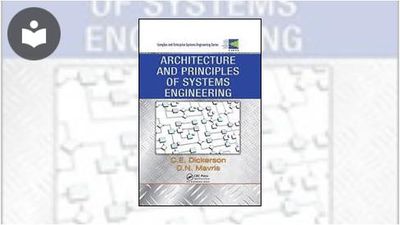Architecture and Principles of Systems Engineering
- 7h 36m
- Charles Dickerson, Dimitri N. Mavris
- CRC Press
- 2010
The rapid evolution of technical capabilities in the systems engineering (SE) community requires constant clarification of how to answer the following questions:
- What is Systems Architecture?
- How does it relate to Systems Engineering?
- What is the role of a Systems Architect?
- How should Systems Architecture be practiced?
A perpetual reassessment of concepts and practices is taking place across various systems disciplines at every level in the SE community.
Architecture and Principles of Systems Engineering addresses these integral issues and prepares you for changes that will be occurring for years to come. With their simplified discussion of SE, the authors avoid an overly broad analysis of concepts and terminology. Applying their substantial experience in the academic, government, and commercial R&D sectors, this book is organized into detailed sections on:
- Foundations of Architecture and Systems Engineering
- Modeling Languages, Frameworks, and Graphical Tools
- Using Architecture Models in Systems Analysis and Design
- Aerospace and Defense Systems Engineering
Describing ways to improve methods of reasoning and thinking about architecture and systems, the text integrates concepts, standards, and terminologies that embody emerging model-based approaches but remain rooted in the long-standing practices of engineering, science, and mathematics. With an emphasis on maintaining conceptual integrity in system design, this text describes succinct practical approaches that can be applied to the vast array of issues that readers must resolve on a regular basis.
An exploration of the important questions above, this book presents the authors’ invaluable experience and insights regarding the path to the future, based on what they have seen work through the power of model-based approaches to architecture and systems engineering.
About the Authors
Professor C.E. Dickerson is the Royal Academy of Engineering Chair of Systems Engineering at Loughborough University in the United Kingdom. His research program at the university is focused on model-driven architecture and systems engineering. He has authored numerous papers as well as an internationally recognized book on military systems architecture, and has co-authored key government reports. As a member of IEEE and OMG, and as the Chair of the INCOSE Architecture Working Group, he works with the systems engineering community on systems architecture practice and standards.
Before joining Loughborough University, he was a Technical Fellow at BAE Systems, providing corporate leadership for architecture-based and system of systems engineering. Previously, as a member of MIT Lincoln Laboratory, he conducted tests and research on electromagnetic scattering. As an MIT IPA, he served as Aegis Systems engineer for the U.S. Navy Theater-Wide Program and then as the Director of Architecture for the Chief Engineer of the U.S. Navy. His aerospace experience includes air vehicle survivability and avionics design at the Lockheed Skunk Works in the Burbank (California) facility and the Northrop Advanced Systems Division, and operations analysis at the Center for Naval Analyses. He received a Ph.D. degree from Purdue University in 1980.
Dimitri Mavris is the Boeing Professor of Advanced Aerospace Systems Analysis at the Guggenheim School of Aerospace Engineering, Georgia Institute of Technology. Throughout his academic career he has authored and co-authored over 60 refereed publications, more than 300 conference papers, and more than 100 technical reports. Since his initial appointment as academic faculty in 1996, Dr. Mavris has graduated more than 110 master’s degree students and 50 doctoral students.
In addition to his academic duties, Dr. Mavris is the founder and director of Georgia Tech’s Aerospace Systems Design Laboratory (ASDL), a unique academic organization home to 200 researchers and graduate-level students actively pursuing research in the areas of multidisciplinary analysis, design, and optimization; MDO/A; and nondeterministic design theory. Since its inception in 1992, ASDL has been named a Center of Excellence in Robust Systems Design and Optimization under the General Electric University Strategic Alliance (GE USA), and a NASA/DoD University Research Engineering Technology Institute (URETI) on Aeropropulsion and Power Technology (UAPT). In addition, ASDL is a member of the Federal Aviation Administration’s Center of Excellence under the Partnership for Air Transportation Noise and Emissions Reduction (PARTNER).
Dr. Mavris is an associate fellow of the American Institute of Aeronautics and Astronautics (AIAA) and fellow of the National Institute of Aerospace. He also serves as Deputy Director for AIAA’s Aircraft Technology Integration and Operations Group and as a Chair for the AIAA Energy Optimized Aircraft and Equipment Systems Program Committee.
In this Book
-
Introduction
-
Logical and Scientific Approach
-
Concepts, Standards, and Terminology
-
Structure, Analysis, Design, and Models
-
Architecture Modeling Languages
-
Applications of SysML to Modeling and Simulation
-
DFD and IDEF0 Graphical Tools
-
Rule and State Modeling
-
Data and Information Modeling
-
Introduction to DoDAF and MODAF Frameworks
-
DoDAF and MODAF Artifacts
-
Other Architecture Frameworks
-
Modeling FBE-I with DoDAF
-
Capabilities Assessment
-
Toward Systems of Systems and Network-Enabled Capabilities
-
Model Driven Architecture
-
Fundamentals of Systems Engineering
-
Capability-Based Acquisition Policy
-
Systems Design
-
Advanced Design Methods
-
Wicked Problems
-
Fleet Battle Experiment-India (FBE-I) Concept Model
-
Air Warfare Model
-
Long-Range Strike System Design Case Study
-
Remote Monitoring



